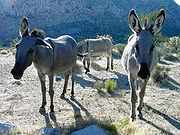
Burro
Encyclopedia

Donkey
The donkey or ass, Equus africanus asinus, is a domesticated member of the Equidae or horse family. The wild ancestor of the donkey is the African Wild Ass, E...
used primarily as a pack animal. In addition, significant numbers of feral
Feral
A feral organism is one that has changed from being domesticated to being wild or untamed. In the case of plants it is a movement from cultivated to uncultivated or controlled to volunteer. The introduction of feral animals or plants to their non-native regions, like any introduced species, may...
burros live in the Southwestern United States, where they are protected by law, and in Mexico. In the western United States, the word "burro" is sometimes used interchangeably with the word "donkey" by English speakers.
Donkeys and other asses
Asinus
The subgenus Asinus encompasses four species and several subspecies of Equidae characterized by long ears, a lean, straight-backed build, a scant tail, and a reputation for considerable toughness and endurance....
were brought by the Spanish
Spain
Spain , officially the Kingdom of Spain languages]] under the European Charter for Regional or Minority Languages. In each of these, Spain's official name is as follows:;;;;;;), is a country and member state of the European Union located in southwestern Europe on the Iberian Peninsula...
to the Americas
Americas
The Americas, or America , are lands in the Western hemisphere, also known as the New World. In English, the plural form the Americas is often used to refer to the landmasses of North America and South America with their associated islands and regions, while the singular form America is primarily...
, where they were prized for their hardiness in arid country. Beginning in the 1840s, the burro became the beast of burden
Working animal
A working animal is an animal, usually domesticated, that is kept by humans and trained to perform tasks. They may be close members of the family, such as guide or service dogs, or they may be animals trained strictly to perform a job, such as logging elephants. They may also be used for milk, a...
of choice by early prospectors in the Southwest United States.
Free-roaming, feral
Feral
A feral organism is one that has changed from being domesticated to being wild or untamed. In the case of plants it is a movement from cultivated to uncultivated or controlled to volunteer. The introduction of feral animals or plants to their non-native regions, like any introduced species, may...
burros in the southwestern United States and parts of Mexico descend from domesticated animals that escaped, were abandoned, or were freed. This burros within certain parts of the United States are protected by , the Wild and Free-Roaming Horses and Burros Act of 1971
Wild and Free-Roaming Horses and Burros Act of 1971
The Wild and Free-Roaming Horses and Burros Act of 1971 , is an Act of Congress , signed into law President Richard M. Nixon on December 18, 1971...
(see also Kleppe v. New Mexico
Kleppe v. New Mexico
Kleppe v. New Mexico, 426 U.S. 529 , was a United States Supreme Court decision, which unanimously held that the Wild and Free-Roaming Horses and Burros Act of 1971 , passed in 1971 by the United States Congress to protect these animals from “capture, branding, harassment, or death,” was a...
). These animals, considered to be a living legacy, are periodically at risk when severe drought conditions prevail. To reduce herd populations and preserve grazing land, the Bureau of Land Management
Bureau of Land Management
The Bureau of Land Management is an agency within the United States Department of the Interior which administers America's public lands, totaling approximately , or one-eighth of the landmass of the country. The BLM also manages of subsurface mineral estate underlying federal, state and private...
conducts roundups of burro herds, which are then sold at public auctions.

